Novel Salinity-Tolerant Third-Generation Hybrid Rice Developed via CRISPR/Cas9-Mediated Gene Editing
Abstract
1. Introduction
2. Results
2.1. Development of OsRR22 Mutagenized Plants
2.2. Characterization of OsRR22 T0 Mutant Plants
2.3. Development of Transgene-Free Mutant and Homozygous Osrr22 Lines
2.4. Novel OsRR22 Alleles Conferring Salt Tolerance
2.5. Analysis of the OsRR22 Amino Acid Sequence of 733Srr22-T1447-1 and HZrr22-T1349-3 Alleles
2.6. Agronomic Trait Analysis of 733Srr22-T1447-1, HZrr22-T1349-3
2.7. Development of the New Promising Third-Generation Hybrid Rice Line with Novel Salt Tolerance
3. Discussion
4. Materials and Methods
4.1. Plant Materials and Wild-Type Growth Conditions
4.2. Vector Construction and Transformation
4.3. Mutant Identification and Characterization in Edited Plants
4.4. Transgene-Free Detection
4.5. Measurement of Salinity Tolerance
4.6. Amino Acid Sequence Analysis
4.7. Agronomic Trait Characterization under Natural Growth Conditions
4.8. Statistical Analysis
Supplementary Materials
Author Contributions
Funding
Institutional Review Board Statement
Informed Consent Statement
Data Availability Statement
Acknowledgments
Conflicts of Interest
References
- Ray, D.; Mueller, N.; West, P.; Foley, J.; Hart, J. Yield trends are insufficient to double global crop production by 2050. PLoS ONE 2013, 8, e66428. [Google Scholar] [CrossRef] [PubMed]
- Mahajan, S.; Tuteja, N. Cold, salinity and drought stresses: An overview. Arch. Biochem. Biophys. 2005, 444, 139–158. [Google Scholar] [CrossRef] [PubMed]
- Munns, R.; Tester, M. Mechanisms of salinity tolerance. Annu. Rev. Plant Biol. 2008, 59, 651–681. [Google Scholar] [CrossRef]
- Kumar, K.; Kumar, M.; Kim, S.; Ryu, H.; Cho, Y. Insights into genomics of salt stress response in rice. Rice 2013, 6, 27. [Google Scholar] [CrossRef]
- Takagi, H.; Tamiru, M.; Abe, A.; Yoshida, K.; Uemura, A.; Yaegashi, H.; Obara, T.; Oikawa, K.; Utsushi, K.; Kanzaki, E.; et al. Mutmap accelerates breeding of a salt-tolerant rice cultivar. Nat. Biotechnol. 2015, 33, 445–449. [Google Scholar] [CrossRef] [PubMed]
- Ma, X.; Feng, F.; Wei, H.; Mei, H.; Xu, K.; Chen, S.; Li, T.; Liang, X.; Liu, H.; Luo, L. Genome-wide association study for plant height and grain yield in rice under contrasting moisture regimes. Front. Plant Sci. 2016, 7, 1801. [Google Scholar] [CrossRef]
- Hussain, M.; Ahmad, S.; Hussain, S.; Lal, R.; Ul-Allah, S.; Nawaz, A. Rice in saline soils: Physiology, biochemistry, genetics, and management. Adv. Agron. 2018, 148, 231–287. [Google Scholar]
- Liu, S.; Zheng, L.; Xue, Y.; Qian, Z.; Lu, W.; Shou, H. Overexpression of OsVP1 and OsNHX1 increases tolerance to drought and salinity in rice. J. Plant Biol. 2010, 53, 444–452. [Google Scholar] [CrossRef]
- Fukuda, A.; Nakamura, A.; Hara, N.; Toki, S.; Tanaka, Y. Molecular and functional analyses of rice NHX-type Na+/H+ antiporter genes. Planta 2011, 233, 175–188. [Google Scholar] [CrossRef]
- Imtiaz, U.M.; Qi, Y.; Satoshi, Y.; Izumi, S.; Deng, X.P.; Soo-Sang, K.; Hironori, K.; Kiyoshi, T. Overexpression of a new rice vacuolar antiporter regulating protein OsARP improves salt tolerance in tobacco. Plant Cell Physiol. 2008, 6, 880–890. [Google Scholar]
- Wang, R.; Jing, W.; Xiao, L.; Jin, Y.; Shen, L.; Zhang, W. The rice high-affinity potassium Transporter1;1 is involved in salt tolerance and regulated by an MYB-type transcription factor. Plant Physiol. 2015, 168, 1076–1090. [Google Scholar] [CrossRef] [PubMed]
- Suzuki, K.; Yamaji, N.; Costa, A.; Okuma, E.; Kobayashi, N.I.; Kashiwagi, T.; Katsuhara, M.; Wang, C.; Tanoi, K.; Murata, Y.; et al. OsHKT1;4 mediated Na+ transport in stems contributes to Na+ exclusion from leaf blades of rice at the reproductive growth stage upon salt stress. BMC Plant Biol. 2016, 16, 22. [Google Scholar] [CrossRef] [PubMed]
- Ren, Z.H.; Gao, J.P.; Li, L.G.; Cai, X.L.; Huang, W.; Chao, D.Y.; Zhu, M.Z.; Wang, Z.Y.; Luan, S.; Lin, H.X. A rice quantitative trait locus for salt tolerance encodes a sodium transporter. Nat. Genet. 2005, 37, 1141–1146. [Google Scholar] [CrossRef] [PubMed]
- Huang, S.; Spielmeyer, W.; Lagudah, E.S.; Munns, R. Comparative mapping of HKT genes in wheat, barley, and rice, key determinants of Na+ transport, and salt tolerance. J. Exp. Bot. 2008, 59, 927–937. [Google Scholar] [CrossRef] [PubMed]
- Liu, C.T.; Mao, B.G.; Ou, S.J.; Wang, W.; Liu, L.C.; Wu, Y.B.; Chu, C.C.; Wang, X.P. OsbZIP71, a bZIP transcription factor, confers salinity and drought tolerance in rice. Plant Mol. Biol. 2014, 84, 19–36. [Google Scholar] [CrossRef] [PubMed]
- Yuan, X.; Sun, H.; Tang, Z.; Tang, H.; Zhang, H.; Huang, J. A novel little membrane protein confers salt tolerance in rice (Oryza sativa L.). Plant Mol. Biol. Report. 2016, 34, 524–532. [Google Scholar] [CrossRef]
- Hasthanasombut, S.; Supaibulwatana, K.; Mii, M.; Nakamura, I. Genetic manipulation of Japonica rice using the OsBADH1 gene from Indica rice to improve salinity tolerance. Plant Cell Tissue Organ Cult. 2011, 104, 79–89. [Google Scholar] [CrossRef]
- Song, S.Y.; Chen, Y.; Chen, J.; Dai, X.Y.; Zhang, W.H. Physiological mechanisms underlying OsNAC5-dependent tolerance of rice plants to abiotic stress. Planta 2011, 234, 331–345. [Google Scholar] [CrossRef]
- Huang, X.Y.; Chao, D.Y.; Gao, J.P.; Zhu, M.Z.; Shi, M.; Lin, H.X. A previously unknown zinc finger protein, DST, regulates drought and salt tolerance in rice via stomatal aperture control. Genes Dev. 2009, 23, 1805. [Google Scholar] [CrossRef]
- Cui, L.G.; Shan, J.X.; Shi, M.; Gao, J.P.; Lin, H.X. DCA1 acts as a transcriptional co-activator of DST and contributes to drought and salt tolerance in rice. PLoS Genet. 2015, 11, e1005617. [Google Scholar] [CrossRef]
- Liu, C.T.; Mao, B.G.; Yuan, D.Y.; Chu, C.C.; Duan, M.J. Salt tolerance in rice:physiological responses and molecular mechanisms. Crop J. 2022, 10, 13. [Google Scholar] [CrossRef]
- Baltes, N.; Voytas, D. Enabling plant synthetic biology through genome engineering. Trends Biotechnol. 2015, 33, 120–131. [Google Scholar] [CrossRef] [PubMed]
- Weeks, D.; Spalding, M.; Yang, B. Use of designer nucleases for targeted gene and genome editing in plants. Plant Biotechnol. J. 2016, 14, 483–495. [Google Scholar] [CrossRef] [PubMed]
- Feng, Z.; Zhang, B.; Ding, W.; Liu, X.; Yang, D.; Wei, P.; Cao, F.; Zhu, S.; Zhang, F.; Mao, Y.; et al. Efficient genome editing in plants using a CRISPR/Cas system. Cell Res. 2013, 23, 1229–1232. [Google Scholar] [CrossRef]
- Hyun, Y.; Kim, J.; Cho, S.; Choi, Y.; Kim, J.; Coupland, G. Site-directed mutagenesis in Arabidopsis thaliana using dividing tissue-targeted RGEN of the CRISPR/Cas system to generate heritable null alleles. Planta 2015, 241, 271–284. [Google Scholar] [CrossRef]
- Li, T.; Liu, B.; Spalding, M.; Weeks, D.; Yang, B. High-efficiency TALEN-based gene editing produces disease-resistant rice. Nat. Biotechnol. 2012, 30, 390–392. [Google Scholar] [CrossRef]
- Nekrasov, V.; Staskawicz, B.; Weigel, D. Targeted mutagenesis in the model plant Nicotiana benthamiana using Cas9 RNA-guided endonuclease. Nat. Biotechnol. 2013, 31, 691–693. [Google Scholar] [CrossRef]
- Svitashev, S.; Young, J.; Schwartz, C.; Gao, H.; Falco, S.; Cigan, A. Targeted mutagenesis, precise gene editing, and site-specifc gene insertion in maize using Cas9 and guide RNA. Plant Physiol. 2015, 169, 931–945. [Google Scholar] [CrossRef]
- Townsend, J.; Wright, D.; Winfrey, R.; Fu, F.; Maeder, M.; Joung, J.; Voytas, D. High-frequency modifcation of plant genes using engineered zinc-fnger nucleases. Nature 2009, 459, 442–445. [Google Scholar] [CrossRef]
- Zhang, A.N.; Liu, Y.; Wang, F.M.; Li, T.F.; Chen, Z.H.; Kong, D.Y.; Bi, J.G.; Zhang, F.Y.; Luo, X.X.; Wang, J.H.; et al. Enhanced rice salinity tolerance via crispr/cas9-targeted mutagenesis of the osrr22 gene. Mol. Breed. 2019, 39, 47. [Google Scholar] [CrossRef]
- Su, N.; Hu, M.; Wu, D.; Wu, F.; Fei, G.; Lan, Y.; Chen, X.L.; Shu, X.L.; Zhang, X.; Guo, X.P.; et al. Disruption of a rice pentatricopeptide repeat protein causes a seedling-specifc albino phenotype and its utilization to enhance seed purity in hybrid rice production. Plant Physiol. 2012, 159, 227–238. [Google Scholar] [CrossRef] [PubMed]
- Zhou, H.; He, M.; Li, J.; Chen, L.; Huang, Z.F.; Zheng, S.Y.; Zhu, L.Y.; Ni, E.; Jiang, D.G.; Zhang, B.R.; et al. Development of commercial thermo-sensitive genic male sterile rice accelerates hybrid rice breeding using the CRISPR/Cas9-mediated TMS5 editing system. Sci. Rep. 2016, 6, 37395. [Google Scholar] [CrossRef] [PubMed]
- Campbell, M.T.; Bandillo, N.; Shiblawi, Ai, A.R.F.; Sharma, S.; Liu, K.; Du, Q.; Schmitz, A.J.; Zhang, C.; Very, A.; Lorenz, A.J.; et al. Allelic variants of OsHKT1;1 underlie thedivergence between indica and japonica subspecies of rice (Oryza sativa) for root sodium content. PLoS Genet. 2017, 13, e1006823. [Google Scholar] [CrossRef] [PubMed]
- Yuan, L.P. Success of the preliminary research on the third generation hybrid rice. Sci. Bull 2016, 61, 3404. [Google Scholar]
- Ma, X.L.; Zhang, Q.Y.; Zhu, Q.L.; Liu, W.; Chen, Y.; Qiu, R.; Wang, B.; Yang, Z.F.; Li, H.Y.; Lin, Y.R.; et al. A robust CRISPR/Cas9 system for convenient, high-efficiency multiplex genome editing in monocot and dicot plants. Mol. Plant 2015, 8, 1274–1284. [Google Scholar] [CrossRef] [PubMed]
- Endo, M.; Mikami, M.; Toki, S. Multigene knockout utilizing of-target mutations of the CRISPR/Cas9 system in rice. Plant Cell Physiol. 2014, 56, 41–47. [Google Scholar] [CrossRef]
- Puchta, H. Applying CRISPR/Cas for genome engineering in plants: The best is yet to come. Curr. Opin. Plant Biol. 2016, 36, 1–8. [Google Scholar] [CrossRef]
- Shen, J.B.; Lv, B.; Luo, L.Q.; He, J.M.; Mao, C.J.; Xi, D.D.; Ming, F. The NAC-type transcription factor OsNAC2 regulates ABA-dependent genes and abiotic stress tolerance in rice. Sci. Rep. 2017, 7, 40641. [Google Scholar] [CrossRef]
- Du, M.M.; Zhou, K.; Liu, Y.Y.; Deng, L.; Zhang, X.Y.; Lin, L.H.; Ming, Z.; Zhao, W.; Wen, C.L.; Xing, J.Y.; et al. A biotechnology-based male-sterility system for hybrid seed production in tomato. Plant J. 2020, 102, 1090–1100. [Google Scholar] [CrossRef] [PubMed]
- Gils, M.; Marillonnet, S.; Werner, S.; Grutzner, R.; Giritch, A.; Engler, C.; Schachschneider, R.; Klimyuk, V.; Gleba, Y. A novel hybrid seed system for plants. Plant Biotechnol. J. 2008, 6, 226–235. [Google Scholar] [CrossRef]
- Khan, M.; Zaidi, S.; Amin, I.; Mansoor, S. A CRISPR way forfastforward crop domestication. Trends Plant Sci. 2019, 24, 293–296. [Google Scholar] [CrossRef] [PubMed]
- Ray, K.; Bisht, N.; Pental, D.; Burma, P. Development of barnase/barstar transgenics for hybrid seed production in Indian oilseed mustard (Brassica juncea L. Czaern & Coss) using a mutant acetolactate synthase gene conferring resistance to imidazolinone-based herbidice ‘Pursuit’. Curr. Sci. 2007, 93, 1390–1396. [Google Scholar]
- Belhaj, K.; Chaparro-Garcia, A.; Kamoun, S.; Patron, N.J.; Nekrasov, V. Editing plant genomes with CRISPR/Cas9. Curr. Opin Biotechnol. 2015, 32, 76–84. [Google Scholar] [CrossRef]
- Jiang, W.Z.; Zhou, H.B.; Bi, H.H.; Michael, F.; Yang, B.; Weeks, D.P. Demonstration of CRISPR/Cas9/sgRNA-mediated targeted gene modification in Arabidopsis, tobacco, sorghum and rice. Nucleic Acids Res. 2013, 20, e188. [Google Scholar] [CrossRef] [PubMed]
- Zhang, H.; Zhang, J.S.; Wei, P.L.; Zhang, B.T.; Gou, F.; Feng, Z.Y.; Mao, Y.F.; Yang, L.; Zhang, H.; Xu, N.F.; et al. The CRISPR/Cas9 system produces specific and homozygous targeted gene editing in rice in one generation. Plant Biotechnol. J. 2014, 12, 797–807. [Google Scholar] [CrossRef]
- Zhou, H.; Bo, L.; Weeks, D.P.; Spalding, M.H.; Bing, Y. Large chromosomal deletions and heritable small genetic changes induced by CRISPR/Cas9 in rice. Nucleic Acids Res. 2014, 17, 10903–10914. [Google Scholar]
- Li, M.R.; Li, X.X.; Zhou, Z.J.; Wu, P.Z.; Fang, M.C.; Pan, X.P.; Lin, Q.P.; Luo, W.B.; Wu, G.J.; Li, H.Q. Reassessment of the four yield-related genes Gn1a, DEP1, GS3, and IPA1 in rice using a CRISPR/Cas9 system. Front. Plant Sci. 2016, 7, 377. [Google Scholar] [CrossRef] [PubMed]
- Shen, L.; Hua, Y.F.; Fu, Y.P.; Li, J.; Liu, Q.; Jiao, X.Z.; Xin, G.W.; Wang, J.J.; Wang, X.C.; Yan, C.J.; et al. Rapid generation of genetic diversity by multiplex CRISPR/Cas9 genome editing in rice. Sci. China Life Sci. 2017, 60, 506–515. [Google Scholar] [CrossRef] [PubMed]
- Song, S.F.; Wang, T.K.; Li, Y.X.; Hu, J.; Li, L. A novel strategy for creating a new system of third generation hybrid rice technology using a cytoplasmic sterility gene and a genic male terile gene. Plant Biotechnol. J. 2020, 19, 251–260. [Google Scholar] [CrossRef]
- Xie, X.; Ma, X.; Zhu, Q.; Zeng, D.; Li, G.; Liu, Y. CRISPR-GE: A convenient software toolkit for CRISPR-based genome editing. Mol. Plant 2017, 10, 1246–1249. [Google Scholar] [CrossRef]
- Hiei, Y.; Ohta, S.; Komari, T.; Kumashiro, T. Efficient transformation of rice (Oryza sativa L.) mediated by Agrobacteriumand sequence analysis of the boundaries of the T-DNA. Plant J. 2014, 6, 271–282. [Google Scholar] [CrossRef] [PubMed]
- Rowland, L.; Nguyen, B. Use of polyethylene glycol for purifcation of DNA from leaf tissue of woody plants. Biotechniques 1993, 14, 734–736. [Google Scholar] [PubMed]
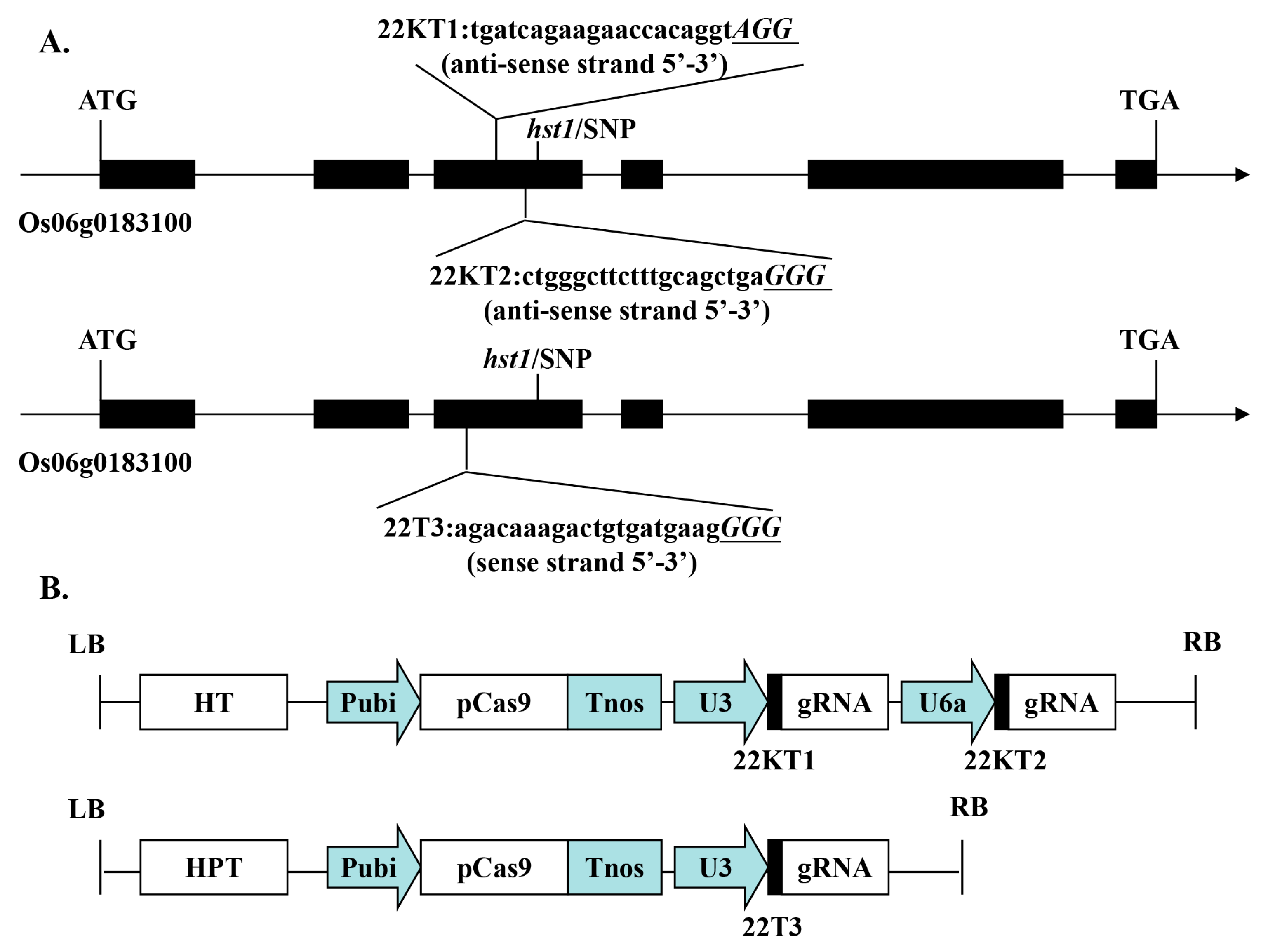
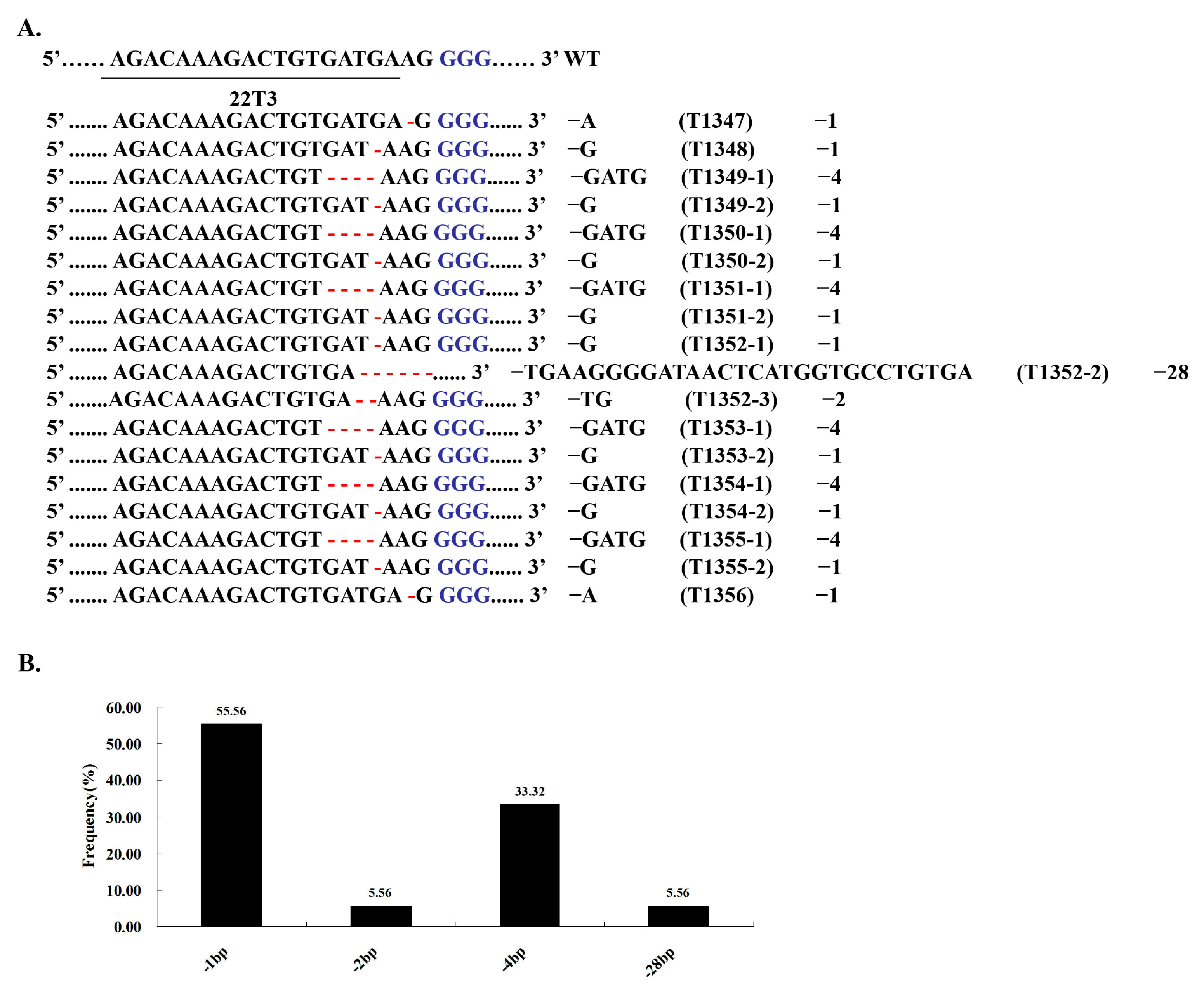
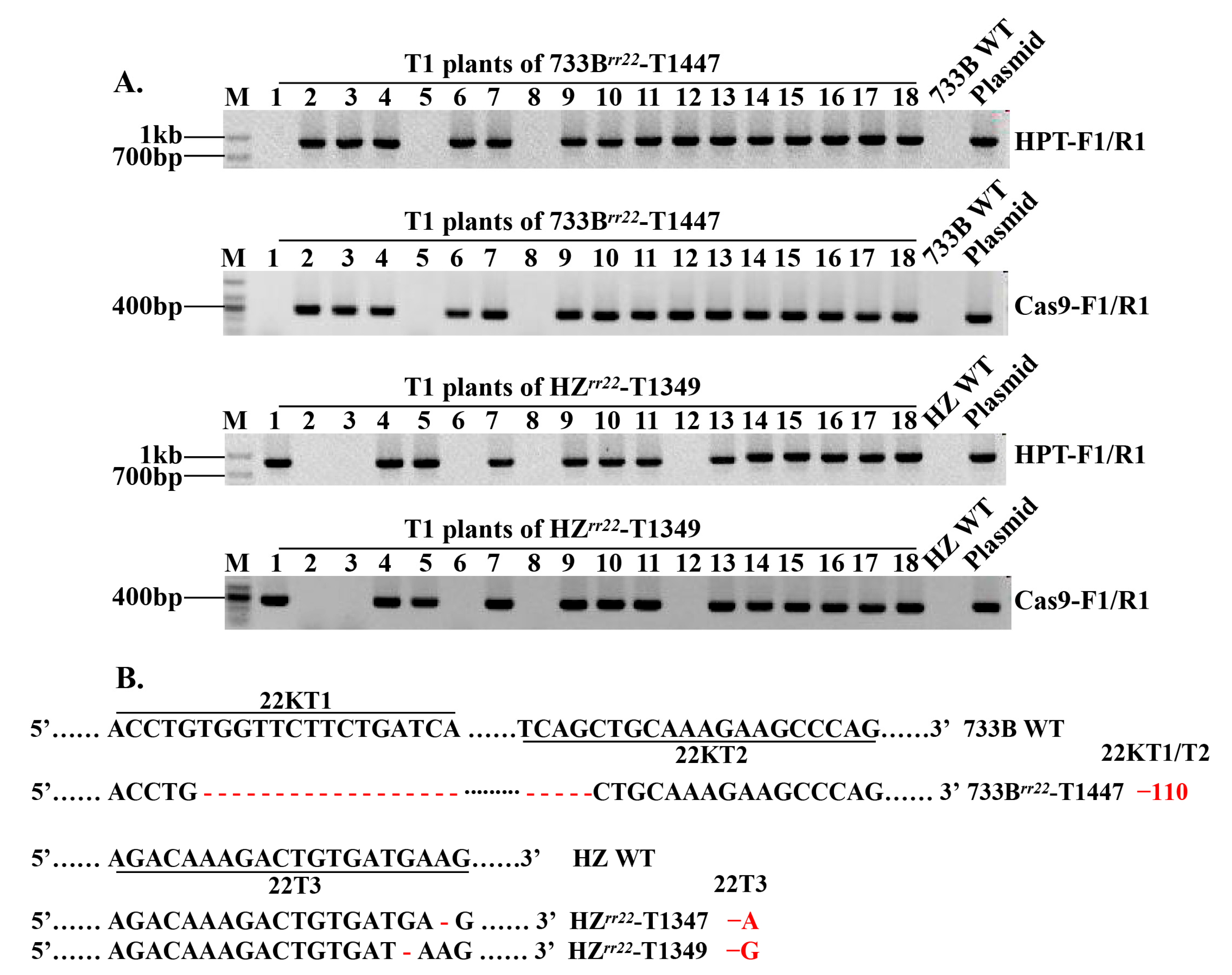
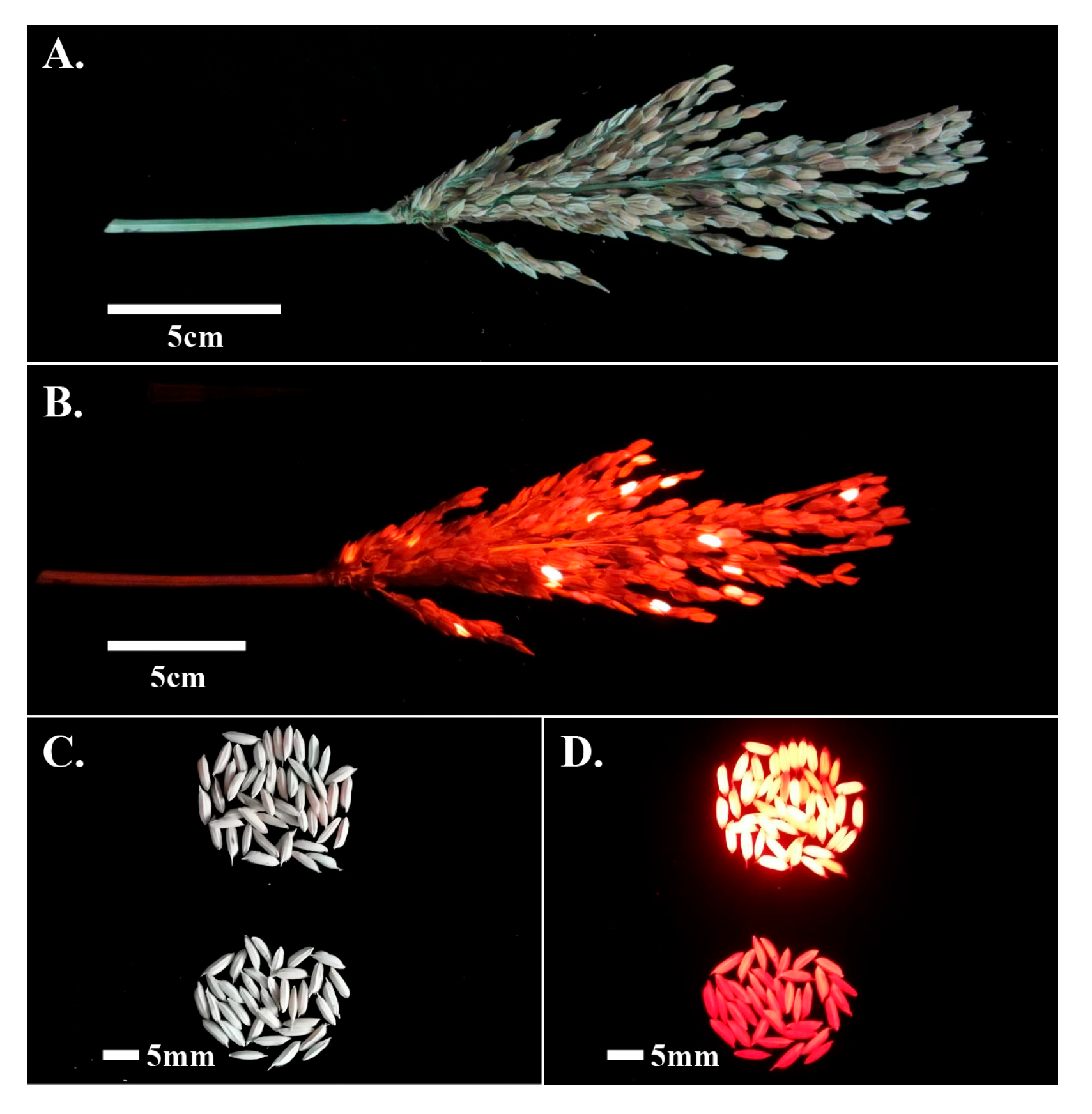

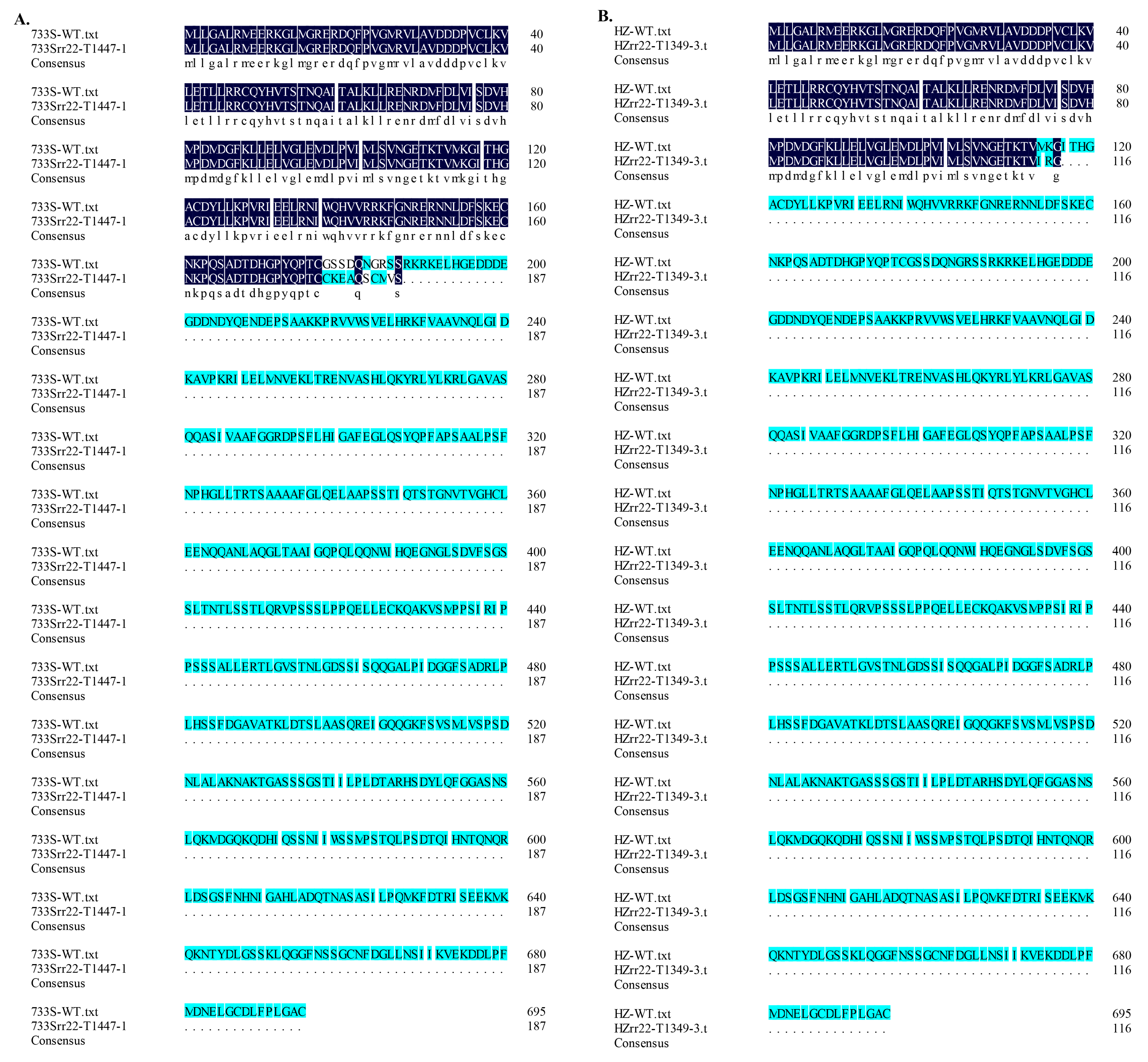
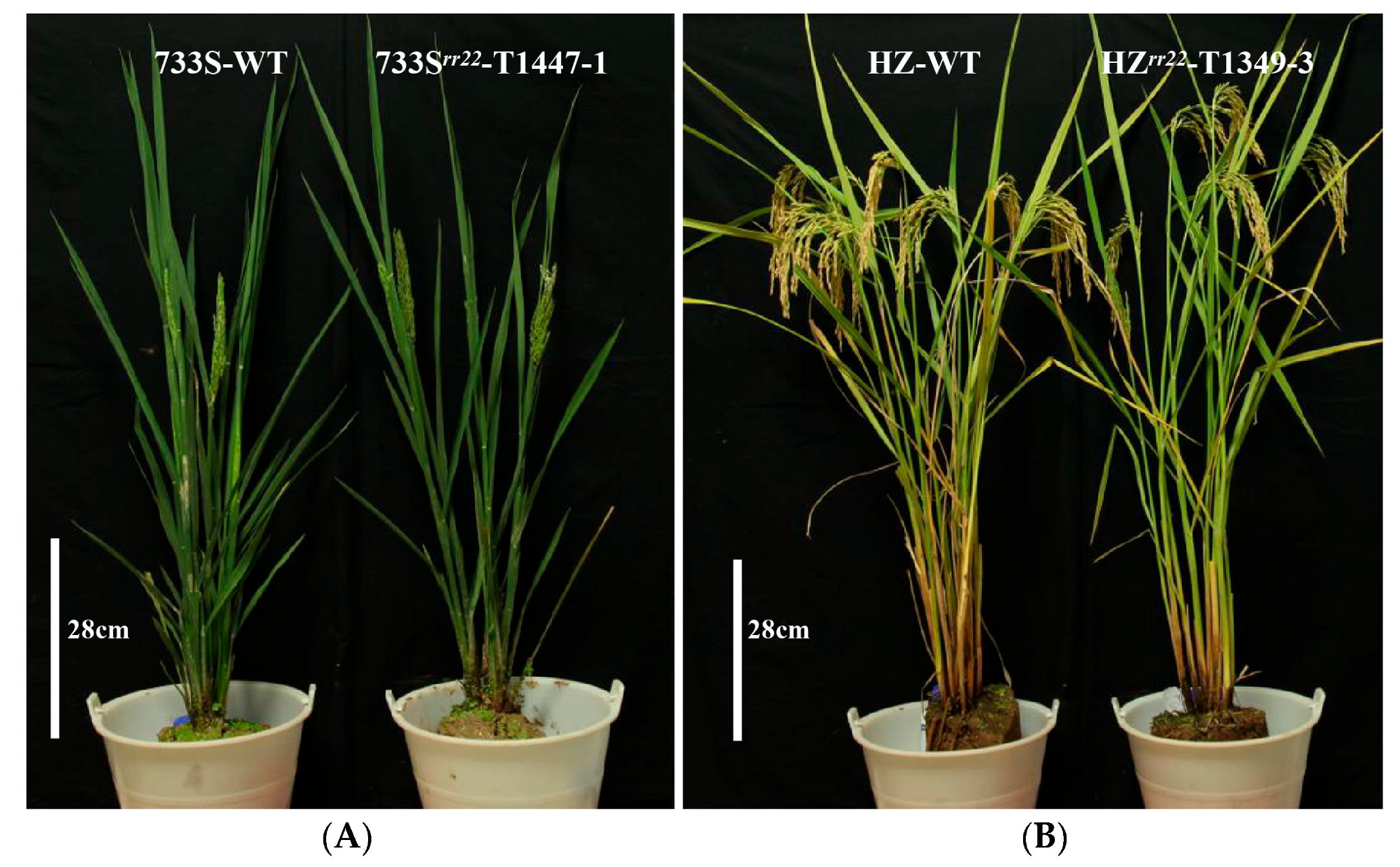
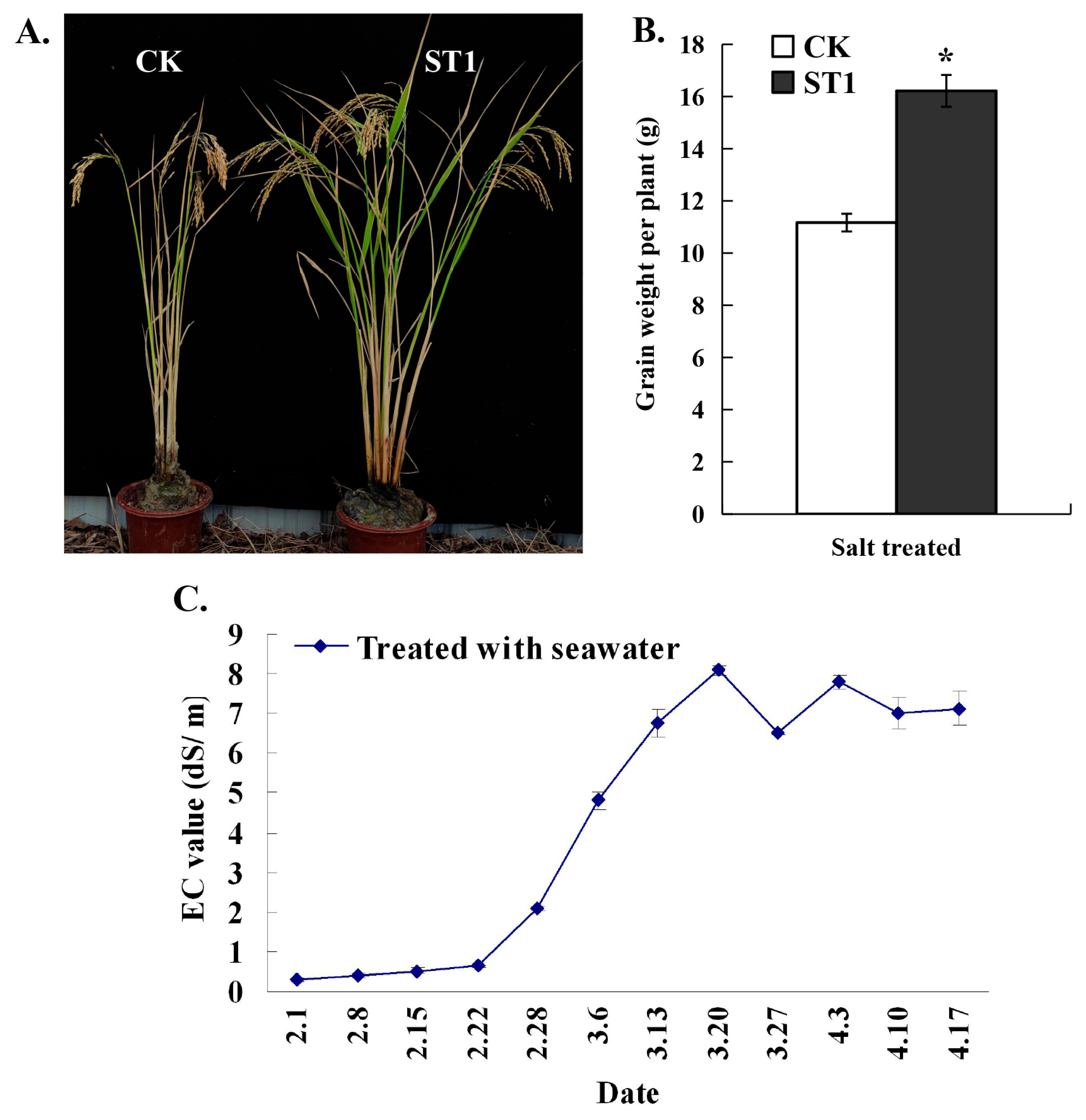
| Line | Seedling Length (cm) | Root Length (cm) | Fresh Weight (g) | Dry Weight (mg) | Survival Ratios (%) |
|---|---|---|---|---|---|
| 733S-WT | 16.67 ± 0.40 | 9.67 ± 1.40 | 0.25 ± 0.05 | 68.67 ± 10.02 | 33.81 ± 0.84 |
| 733Srr22-T1447-1-T3 | 22.17 ± 0.76 * | 11.63 ± 2.41 | 0.92 ± 0.18 * | 183.00 ± 9.54 * | 72.05 ± 3.34 * |
| HZ-WT | 21.93 ± 0.95 | 5.70 ± 1.04 | 0.15 ± 0.03 | 57.00 ± 7.55 | 29.89 ± 3.00 |
| HZrr22-T1347-6-T3 | 24.63 ± 1.33 * | 9.47 ± 0.90 * | 0.46 ± 0.06 * | 86.00 ± 8.00 | 47.69 ± 2.28 * |
| HZrr22-T1349-3-T3 | 29.53 ± 0.92 * | 10.40 ± 1.22 * | 0.73 ± 0.07 * | 185.00 ± 10.82 * | 61.48 ± 2.79 * |
| Lines | Plant Height (cm) | The Number of Tillers per Plant | The Number of Grains per Panicle | Spikelet Fertility (%) | 1000-Seed Weight (g) |
|---|---|---|---|---|---|
| 733S-WT | 92.80 ± 3.24 a | 4.20 ± 0.45 a | 557.00 ± 52.63 a | - | - |
| 733Srr22-T1447-1 | 92.40 ± 1.31 a | 4.40 ± 0.55 a | 542.00 ± 34.58 a | - | - |
| HZ-WT | 116.34 ± 2.34 b | 11.60 ± 1.51 b | 241.60 ± 17.24 b | 78.47 ± 4.18 b | 17.37 ± 0.35 b |
| HZrr22-T1349-3 | 117.15 ± 1.26 b | 11.20 ± 1.34 b | 217.40 ± 10.97 b | 76.25 ± 3.73 b | 17.13 ± 0.16 b |
Disclaimer/Publisher’s Note: The statements, opinions and data contained in all publications are solely those of the individual author(s) and contributor(s) and not of MDPI and/or the editor(s). MDPI and/or the editor(s) disclaim responsibility for any injury to people or property resulting from any ideas, methods, instructions or products referred to in the content. |
© 2023 by the authors. Licensee MDPI, Basel, Switzerland. This article is an open access article distributed under the terms and conditions of the Creative Commons Attribution (CC BY) license (https://creativecommons.org/licenses/by/4.0/).
Share and Cite
Sheng, X.; Ai, Z.; Tan, Y.; Hu, Y.; Guo, X.; Liu, X.; Sun, Z.; Yu, D.; Chen, J.; Tang, N.; et al. Novel Salinity-Tolerant Third-Generation Hybrid Rice Developed via CRISPR/Cas9-Mediated Gene Editing. Int. J. Mol. Sci. 2023, 24, 8025. https://doi.org/10.3390/ijms24098025
Sheng X, Ai Z, Tan Y, Hu Y, Guo X, Liu X, Sun Z, Yu D, Chen J, Tang N, et al. Novel Salinity-Tolerant Third-Generation Hybrid Rice Developed via CRISPR/Cas9-Mediated Gene Editing. International Journal of Molecular Sciences. 2023; 24(9):8025. https://doi.org/10.3390/ijms24098025
Chicago/Turabian StyleSheng, Xiabing, Zhiyong Ai, Yanning Tan, Yuanyi Hu, Xiayu Guo, Xiaolin Liu, Zhizhong Sun, Dong Yu, Jin Chen, Ning Tang, and et al. 2023. "Novel Salinity-Tolerant Third-Generation Hybrid Rice Developed via CRISPR/Cas9-Mediated Gene Editing" International Journal of Molecular Sciences 24, no. 9: 8025. https://doi.org/10.3390/ijms24098025
APA StyleSheng, X., Ai, Z., Tan, Y., Hu, Y., Guo, X., Liu, X., Sun, Z., Yu, D., Chen, J., Tang, N., Duan, M., & Yuan, D. (2023). Novel Salinity-Tolerant Third-Generation Hybrid Rice Developed via CRISPR/Cas9-Mediated Gene Editing. International Journal of Molecular Sciences, 24(9), 8025. https://doi.org/10.3390/ijms24098025





